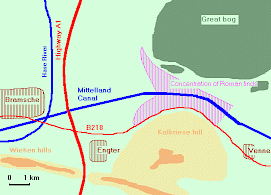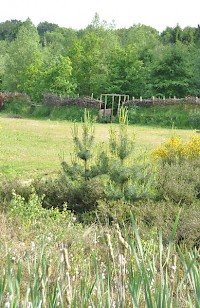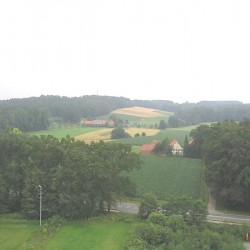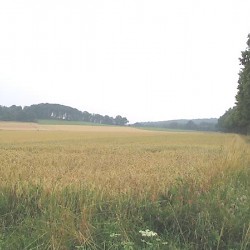Kalkriese
Q1954771Kalkriese: site of one of the fights of the Battle in the Teutoburg Forest (9 CE).

In September 9 CE, the Romans suffered one of the greatest defeats in their history in the Teutoburg Forest. Three legions (the Seventeenth, Eighteenth, and Nineteenth) were destroyed; general Publius Quintilius Varus was forced to commit suicide. The site of one of the fights of this battle has been discovered at Kalkriese, north of modern Osnabrück.
Here is a small strip of solid land between the Kalkrieser Berg (Mount Kalkriese) and a great bog. The most accessible part of this zone was a strip of cultivated land with a width of only 220 meters. This could well have been called "narrows" or saltus; the Roman name Saltus Teutoburgiensis, often rendered as "Teutoburg Forest", should be translated as Teutoburg Narrows. In fact, one of the towns in the neighborhood is still called Engter, "narrows".

At the Kalkriese Museum, this narrow passage has partly been reconstructed: see the photo to the right. In front, you can see the bog; then, a small strip of land, and finally the slopes of the tree-covered mountain, which have been fortified with a palisade.
The Germanic leader Arminius, who was believed to be a Roman ally, guided the legions to these narrows and unexpectedly attacked his former friends. The results were terrible, as was shown during the excavation. Archaeologists found so many objects, that it was hard to believe that the fight at Kalkriese was a minor skirmish: Roman swords and daggers, parts of javelins and spears, arrowheads, sling stones, fragments of helmets, a mask, nails of soldiers' sandals, belts, hooks of chain mail and fragments of armor.
Other finds were less military in character: locks, keys, razors, a scale, weights, chisels, hammers, pickaxes, buckets, finger rings, surgical instruments, seal boxes, a stylus, cauldrons, casseroles, spoons, amphoras, and the skeleton of an oxen that had broken away from the cart, and was never recovered by its owner. Finally, jewelry, hairpins, and a disk brooch suggest the presence of women. One of the most dazzling pieces of the museum's collection is a mask, once owned by a cavalry man. It was discovered in front of the wall.
It is important to consider the distribution of the finds (see map top right), which suggests that this is the place where an army, arriving from the east and proceeding to the west, was no longer able to continue in one column and fell apart. One column went to the southwest, another to the northwest.
 Kalkriese, Gold coin of Augustus |
 Kalkriese, Roman slingstones |
 Kalkriese, Skull and bones |
 Kalkriese, Face mask of a cavalry helmet |
According to the historian Cassius Dio, whose account can be read here, the army was able to reorganize itself and tried to build a new fortress. An obvious place to look would have been near modern Engter, where the Romans could cross the mountains and proceed to Haltern. More finds may be expected in the area of Osnabrück and Münster.
Today, the Kalkriese area is a tranquil piece of land. There is a museum that gives the visitor an impression of the puzzle itself, and you can visit the field where most discoveries were made. Near the museum is a large tower so that you understand the environment: a mountain to the south, a bog to the north, and a narrow corridor.
 Kalkrieser Berg |
 Kalkriese, General view of the field |
 Kalkriese, Excavation |
 Engter |
In the nineteenth century, many Germans believed that the battle in the Kalkriese narrows had been the birth of their nation: a symbol of the eternal opposition between the overcivilized and decadent Latin people and the creative and vital Germanic people. To make the connection between the noble savages of Antiquity and the modern nation closer, the Germanic war leader - whose name had been rendered by the Roman writers as Arminius - was referred to with a German name: Hermann.

The ancient war hero soon became a symbol of German national unity and could be used on almost any occasion. For example, in 1809, the romantic poet Heinrich von Kleist (1777-1811) wrote a play called Die Hermannsschlacht, to inspire the Germans to a national war against Napoleon. Several football teams were called after the Germanic warrior; Arminia Bielefeld still exists.
At Detmold, which was once believed to have been the site of the battle, the Hermannsdenkmal (Hermann Monument) was erected in 1875. Ironically, during the Second World War, the monument served to help the allied bombers find the way to Berlin. The symbolic creator of the German nation was instrumental to the country's destruction - or at least the Nazi part of it.